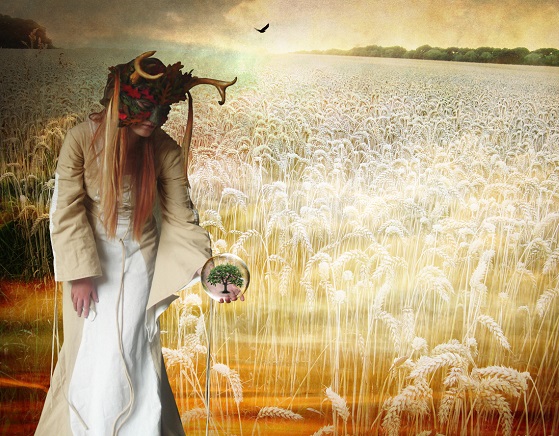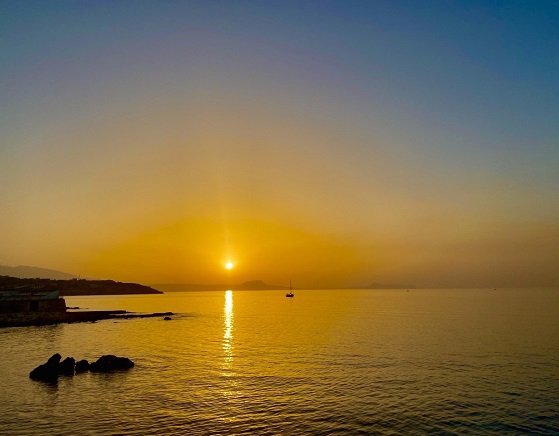Prelapsarian Paradise: Nature Will Triumph.

{source}
The beads of salt water caught the sun and burned incandescently on the deck before scattering like comets when the ferry rocked.
The boat was iridescent under a topaz sky, we seemed to slice through the Aegean faster than the boat I arrived to Santorini on, we were headed to Crete.
Piercing the sea like a spear slicing a frothing spume on either side of us, flecking our faces with sun-speckled saline as we gazed at the vast blue world.
It’s amazing to me that the ancients traveled on frail wooden vessels in this cerulean infinity, even on such an impressive nautical juggernaut I could feel the endlessness above and below me.
Oscillations pulling me towards the heavens and then to the depths in a churning rhythm, the low hum of the engine muted by the thunder of wind and waves.
The heatwaves that consumed Greece were hotter than any in decades, they created a searing blue world that we glistened in like bubbles in molten indigo glass.
I felt relief, even as I was fascinated by Santorini; the richness of its history and its stories imprinted into its foundation, I couldn’t help but feel the sleeping power of the volcano that decimated the island in ancient times.
Lying on the volcanic black-sand beach or falling asleep to the sound of wind sighing over rocks every night which could seem like a distant, ominous roar.
Heading to Crete following an ancient route of trade between the islands, and perhaps, during that fateful moment when the volcano erupted with more power than two million atomic bombs, a path of escape.
I thought of those who felt the earth tremble, those who sensed the looming cataclysm in time to change their course, to navigate away from danger.
Crete holds the echoed splendors of the Minoan civilization, an Edenic paradise of Eurasian and Mediterranean culture.
Gorgeous frescoes were found on walls in labyrinthine structures that have inspired legends that endure to this day.
A social structure where women were afforded greater power and standing, as priestesses and arbiters of the social fabric.
Art that sampled style and forms from many places, like Egypt, creating a gorgeous synthesis of aesthetic that was both dynamic and stylized, ornate yet possessing a scintillating power.
It portrayed a jewel-toned reflection of people, animals and the sea that brought the tastes and treasures of the world to their sun-dappled shores.
This was before the eruption, which spared Crete the kind of billowing, fiery death that Thera (Santorini) was consumed by, but was so great it would create a global winter, and Thera’s neighbor was not spared a slow, agonizing demise.
The sky was stalked by a death-cloud, and Crete was soon encroached upon not only by the shroud but a devastating tsunami that pulled the sea from around the island and then crashed over it, in some places the water was higher than the island itself.
The ash cloud was a slower attack but no less fearsome for its languor, choking crops and casting the Minoans in a shadow of fear and famine.
As the people starved, the ash cloud loomed gluttonous and gloating, engorged, it blocked the light for years.
This was not supposed to happen; the Minoans flourished under the protection of myriad local goddesses, and perhaps major goddesses of more primacy and greater power.
It’s theorized that these multiple goddesses were meant to control aspects of nature like the ripening of crops and fair weather, while a Mother Goddess would have held more sway. It’s been stated by an expert that the Phaistos Disc is dedicated on one side to a Mother Goddess and on the other Astarte.
Astarte was a deity of primacy for the Neolithic farmers of Anatolia, who are said to be the first settlers of Crete.
We can envision this gorgeous prelapsarian paradise; a place of trade and cultural sharing, glistening in the Aegean as a nexus of beauty and civilization.
In addition to the exquisite frescoes and structures were paved roads and running water, this place was a marvel.
A magical place blessed by goddesses and ruled by priestesses, that resonated with the shimmering dynamism of East and West.
While the neighboring Mycenaeans were warlike and patriarchal, the people of Crete enjoyed, for a time, an oasis of resplendence.
I think now about the time after the eruption, the tendrils of destruction darkening the heavens, the moment where disaster seemed both distant and ineluctable.
Archeologists depict the turmoil uprooting the mores and ethos that made the Minoan society so exquisite.
As the sky turned oppressive and crops failed, so too the culture became seized by a reflective darkness all its own.
In time the goddesses of the past were demoted, the famous snake goddess statues were found dismembered and buried, so thoroughly had the deities shifted in importance.
The time of harmonious goddess worship was no more.
A new being was elevated, possibly a minor deity given a new importance, a Boy God. We know this shifting jockeying of cosmic power by the machinations of worshipers depicted in burnt ivory and scattered rock crystal, smashed limbs and buried relics.
A kouros statue was found destroyed by arson, and it’s thought that this Boy God that usurped the goddesses of Crete after they failed to protect the island from despair and doom was not well-received by all.
This ideal form represented something too novel, too different — a threat.
The Minoans were gripped in a miasma of fear and anger, reflected by the relics of the representative deities-turned-effigies.
Fear stoked tribalism and fundamentalism, as ever.
A fearful reproach that turns away from nature goddesses and towards an idealized male youth, this seems to me to be an archetypal pattern reflected in our own times.
Not a perfect corollary, but The Great Mother and The Puer are archetypes found in reflection and reaction to each other in many iterations, and I think there’s insight to be gleaned in the comparison.
Today, the cult of the Boy God is Christianity, and the pivot away from Mother Goddess energy can be seen embodied by a culture that sees our relationship to nature as one of dominion and extraction.
A frightened shift from the overwhelming power of the natural world and towards a transcendent male figure, a gleaming paragon of masculine triumph over nature.
In this new iteration of the male god savior, we as humans are placed not as interwoven facets of nature, but as rulers over it.
The cult of the redeeming youth deity is now entwined with a carnivorous and unscalable capitalist profit-and-extraction relationship with the world, the cult of the individual reigns supreme even as nature warns us of where the power truly lies.
As the heat shimmers off the sea and the skies above Greece darken with fires fueled by climate change, it’s apparent that nature will triumph.
There’s no true transcendence over her in the mortal coil, save the transcendence of spirit.
There is a balance that can be held — the idea of an individual divinity and the matrix of nature that cares nothing for the individual.
This balance cannot be found in the modern incarnation of the Puer archetype as Christ.
Now harnessed diabolically by the Evangelical Right to ensnare blind followers in their pitiless, doomed enterprises that have infiltrated commerce and now lay waste to the balance that humans might have with nature.
This is an abomination of the archetype of the sacred individual, the innovator and the inventor, who I believe are the true saviors of our time.
Those who value their autonomy but can still perceive an interrelatedness with the natural world, who can cull from that relationship medicines and methods and magic in the arts.
We can learn from the Minoan culture, from both epochs, one of harmonious distribution of power and wealth, of cultural sharing and inspiration, and one of battles for power that pitted people and gods against each other.
We can see the gods as archetypes, energy patterns, and we can understand that all archetypes can become unbalanced when they vie for ascendency.
We can glean lessons of cooperation and dominion, and we can begin to accept that all human activity exists under the power of nature, the laws of which painter, poet and potentate are all subject to.
The betrayal that shifted the Minoans away from the goddess and towards the Boy God in merciless rivalry doesn’t have to be our myopic fate.
We understand that cooperation with nature is not the same as appeasement and safety. In this age, we know that our interaction with nature can create harm, but that harm can be ameliorated with remedial action.
Just as we understand the next cataclysmic event could come without warning: cooperation does not mean assured benevolence.
With this knowledge, we are both free as individual beings, unique as any natural thing, as transcendent as our own spirit allows, and divinely interwoven into the fabric of all things.
***
Maren Zweifler enjoys teaching Yoga with a focus on free movement and intrinsic shapes, emphasizing spinal fluidity and innate, primal posture. Deeply inspired by movement systems that embrace nature like Sridaiva and Continuum Movement. He completed a 500-hour certification in SF and has taught both there and in Austin where he honed his skills teaching private classes tailored to the individual needs of his clients. He created a wellness/yoga program at a non-profit. These experiences allowed him to explore both the unique individuation of the physical experience in one-on-one sessions, and the commonalities of the human form that can be witnessed in large groups. You could connect with Maren on Instagram.


